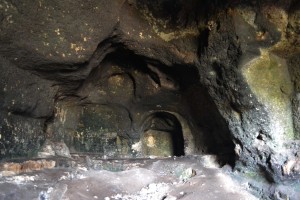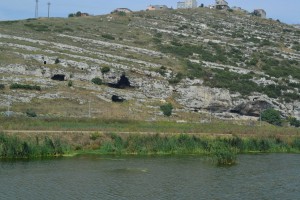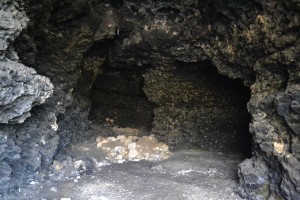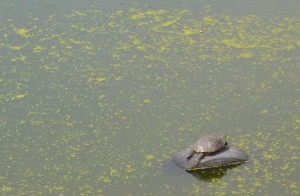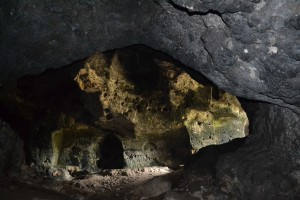This may be Istanbul’s most significant archaeological site. It is primarily of interest for its evidence of hominid settlement in the Pleistocene and there has been a lot of study of the cave bear bones found inside, especially their relationship with Palaeolithic weapons that might have killed them.
Human habitation continued until Byzantine times and there is a church cut into the rock in the upper cave. This is superficially similar to the Aya Nikola Monastery in Kıyıköy and Mamboury advances the idea that this was a church of St Theodore. The whole place is a minefield of archaeological argument but it is a wonderful place to explore. The protection of the iron grilles installed to prevent people entering is minimal as the gap between bars allows even me to enter, let alone those with the more lean physiques normally associated with youthful vandalism. However, the main damage has been done by film crews for whom this is a common location. Yusuf and Emir, the young guardians of the cave, listed a Who’s Who of Turkish actors whom they had seen filming here. They told me the legend of the tunnel in the lower cave that allegedly goes all the way to Topkapı Palace. It goes about 600m (in roughly the right direction, admittedly). There were once some spectacular wall paintings there that did not survive until the 21st century.
Across the Sazlıdere River is another cave belonging to the same settlement. There is little of importance here, but the grilles are much more secure. The river itself appears polluted but the old car tyres are favoured by a large population of turtles which like to sun themselves on them.
The access situation has changed as of September 2016. The grilles have been repaired and not even small boys can get through. I arrived at the site and almost immediately a Zabita van from Başakşehir Belediyesi arrived. Three uniformed policemen got out, shook my hand and unlocked the gate to the cave. Apparently, you can call 444 0 669 and someone will come and let you in. The advantage of this is that vandalism and treasure-hunting excavations are no longer destroying what is left in the cave. The downside is that you can’t stay in the cave for very long and extended exploration of the long tunnel with its bats and calcite formations will now require tedious official preparation.
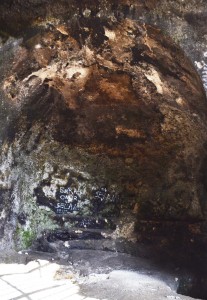
Apse with synthronon of church near entrance of upper chamber
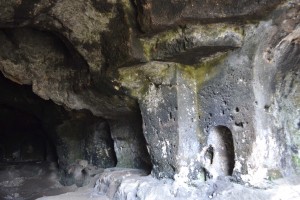
South wall of upper chamber showing extensive Byzantine remains
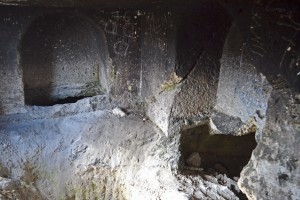
Necropolis with three large burial chambers about 12m above the main chamber
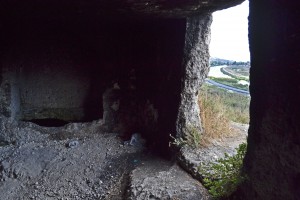
View south from necropolis along Sazlıdere towards Küçükçekmece
Arsebük, G., F.C. Howell, S.L. Kuhn, W.R. Farrand, M. Özbaşaran, M.C. Stiner. (2010) Chapter 1: The caves of Yarımburgaz: Geological context and history of investigation. In (Howell et al., Eds.) Culture and Biology at a Crossroads: The Middle Pleistocene Record of Yarimburgaz Cave (Thrace, Turkey). Zero Books/Ege Publications, Istanbul, pp. 1-27. Available online at: https://www.academia.edu/969121/Chapter_1_The_caves_of_Yar%C4%B1mburgaz_Geological_context_and_history_of_investigation Accessed Sept 1 2016(2010)
Arsebük, G., F.C. Howell, M. Özbaşaran, (1998) Yarımburgaz “1988” in XI Kazı Sonuçlar Toplantası I. T.C. Kültür Bakanlığı Anıtlar ve Müzeler Genel Müdürlüğü pages 9 – 38 Available online at: http://www.kulturvarliklari.gov.tr/sempozyum_pdf/kazilar/11_kazi_1.pdf Accessed Sept 4 2016
TAY Project (2000) Yarımburgaz Mağarası. The Archaeological Settlements of Turkey. http://www.tayproject.org/TAYmaster.fm$Retrieve?YerlesmeNo=2826&html=masterengdetail.html&layout=web Accessed Sept 4 2016

Categories: Uncategorized | No Comments »
